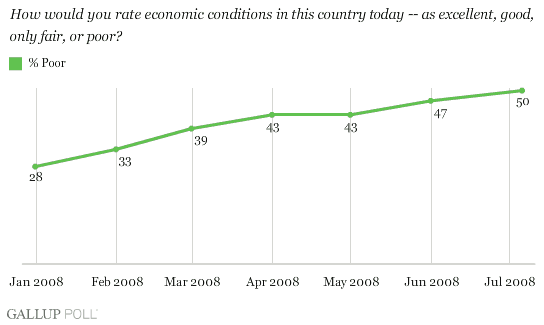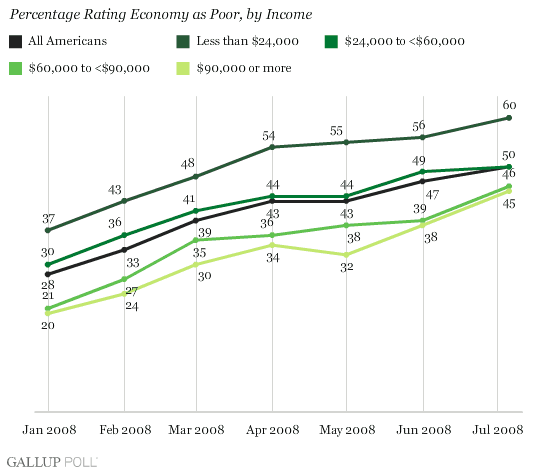PRINCETON, NJ -- During early July, new Gallup polling shows that the percentage of Americans rating current economic conditions as "poor" averaged 50% -- up from 47% in June, and 43% in April and May.

Consumer Perceptions Decline Across Income Distribution
On Friday, the Reuters/University of Michigan preliminary Index of Consumer Sentiment will be announced. Gallup's survey of more than 3,000 consumers (conducted June 30-July 6) suggests that consumer perceptions of the current economy continued to plunge in early July. In turn, this implies that other measures of consumer attitudes toward the current economy conducted in early July should also show a decline. (Gallup's and others' estimates also include measures of the economy's direction. Gallup's measure of the economy's direction was essentially unchanged in early July.)
Gallup's daily tracking of consumer perceptions of the current economy shows that the percentage of consumers rating current economic conditions as "poor" continued to increase in early July, averaging 50%, which essentially matches the highest level recorded since Gallup began asking the question in 1992. Significantly, the continuing decline in consumer ratings of current economic conditions took place across the income spectrum. The percentage of lower-income Americans (those making less than $24,000 a year) who rate current economic conditions as "poor" increased from 56% in June to 60% in early July. "Poor" ratings also increased among those making at least $90,000 a year (from 38% in June to 45% in early July) and $60,000 to less than $90,000 (from 39% to 46%). Only among those making $24,000 to less than $60,000 were "poor" ratings basically unchanged (from 49% to 50%).

Commentary
Given all the bad economic news of the past couple of weeks, it is not clear whether the markets will react negatively to the continuing decline in consumer perceptions that is taking place in early July. However, whether the Index of Consumer Sentiment shows it or not, consumer pessimism continues to worsen, and is at historically low levels.
Even more troubling, consumer perceptions continue to worsen among higher-income Americans. Their ratings of the economy are not as bad as ratings of those with lower incomes, but they are near historical lows for all Americans. And, the early July views of those with higher incomes stand in sharp contrast to their views in January, when nearly twice as many higher-income Americans rated current economic conditions "excellent" or "good" as rated them "poor."
Economists and market analysts have long debated whether there is a direct link between consumer perceptions and consumer spending. Whichever side one takes on that debate, it is clear that consumers are reaching a tipping point in their perceptions of the U.S. economy. Overall consumer psychology plays a role not only in day-to-day spending but also in all consumer decision-making. Today's overwhelmingly negative sentiment might not only lead consumers to pull back in the short term, but could affect consumer perceptions for a much longer period, as has been the case in Japan.
As the presidential candidates consider their future economic plans, they would do well to think about how they go about creating a significant change in consumer perceptions moving forward. U.S. economic problems may no longer be limited to individual markets and/or income groups, but could extend to a prolonged period of overall negative consumer psychology.
Survey Methods
Gallup is interviewing no fewer than 1,000 U.S. adults nationwide each day during 2008. The economic questions analyzed in this report are asked of a random half-sample of respondents each day. The results reported here are based on combined data of more than 8,000 interviews in January, February, March, April, May, and June. For results based on this sample, the maximum margin of sampling error is ±1 percentage point.
The questions for the first week of July are based on combined data of more than 3,000 interviews conducted June 30 to July 6, 2008. For results based on this sample, the maximum margin of sampling error is ±2 percentage point.
Interviews are conducted with respondents on land-line telephones (for respondents with a land-line telephone) and cellular phones (for respondents who are cell-phone only).
In addition to sampling error, question wording and practical difficulties in conducting surveys can introduce error or bias into the findings of public opinion polls.
To provide feedback or suggestions about how to improve Gallup.com, please e-mail feedback@gallup.com.
